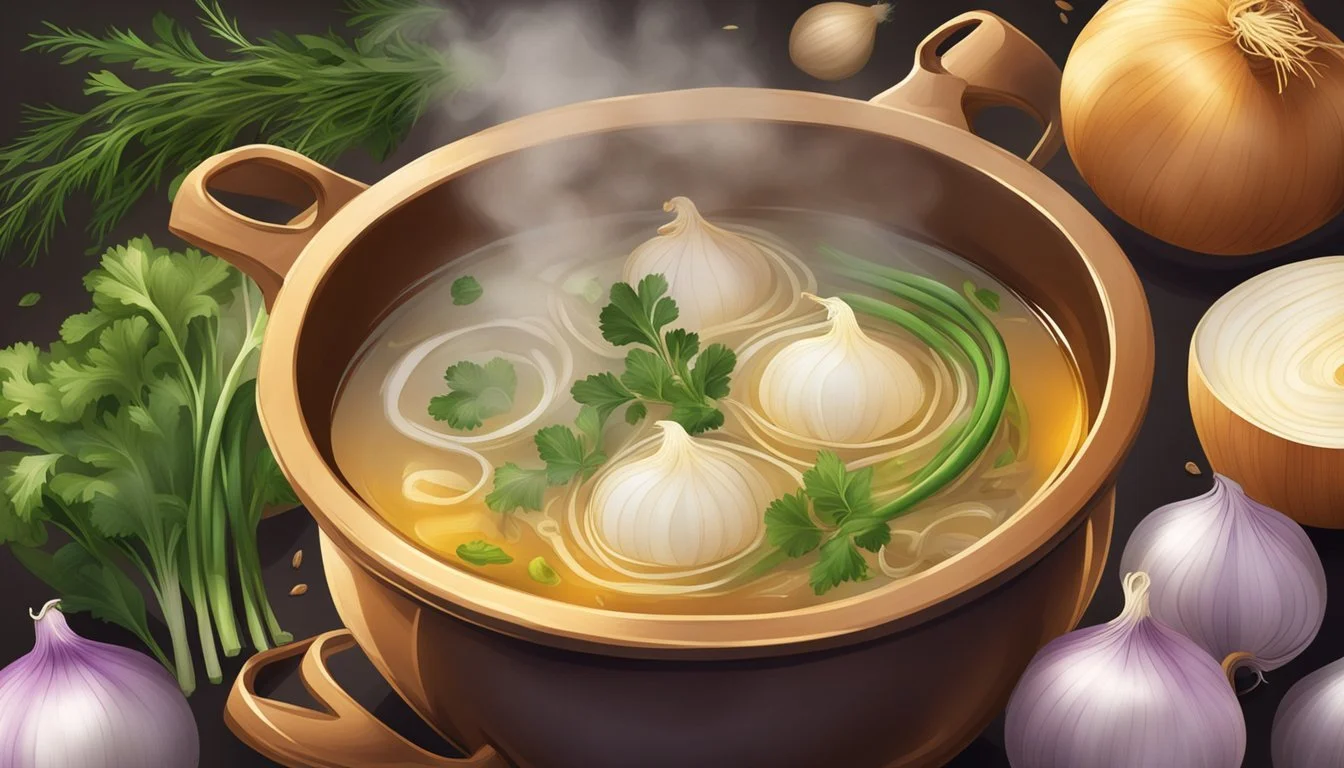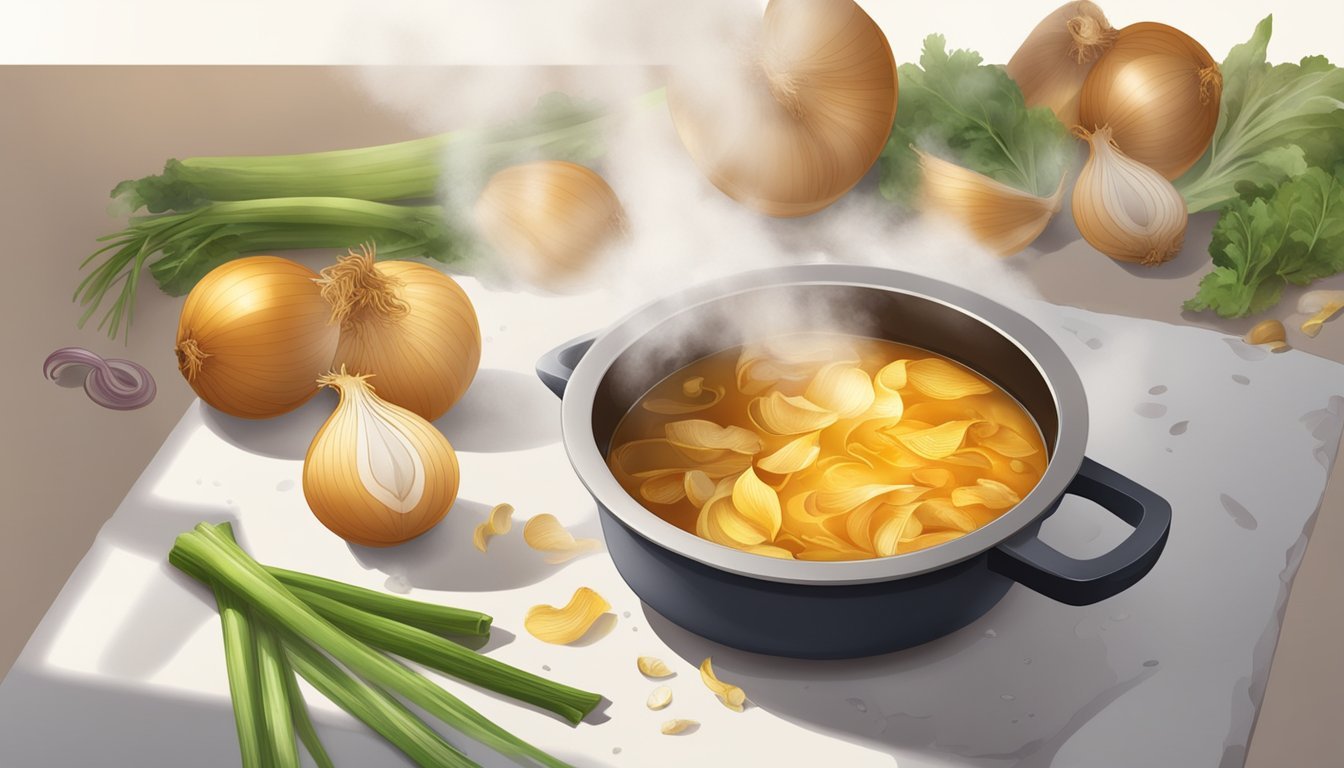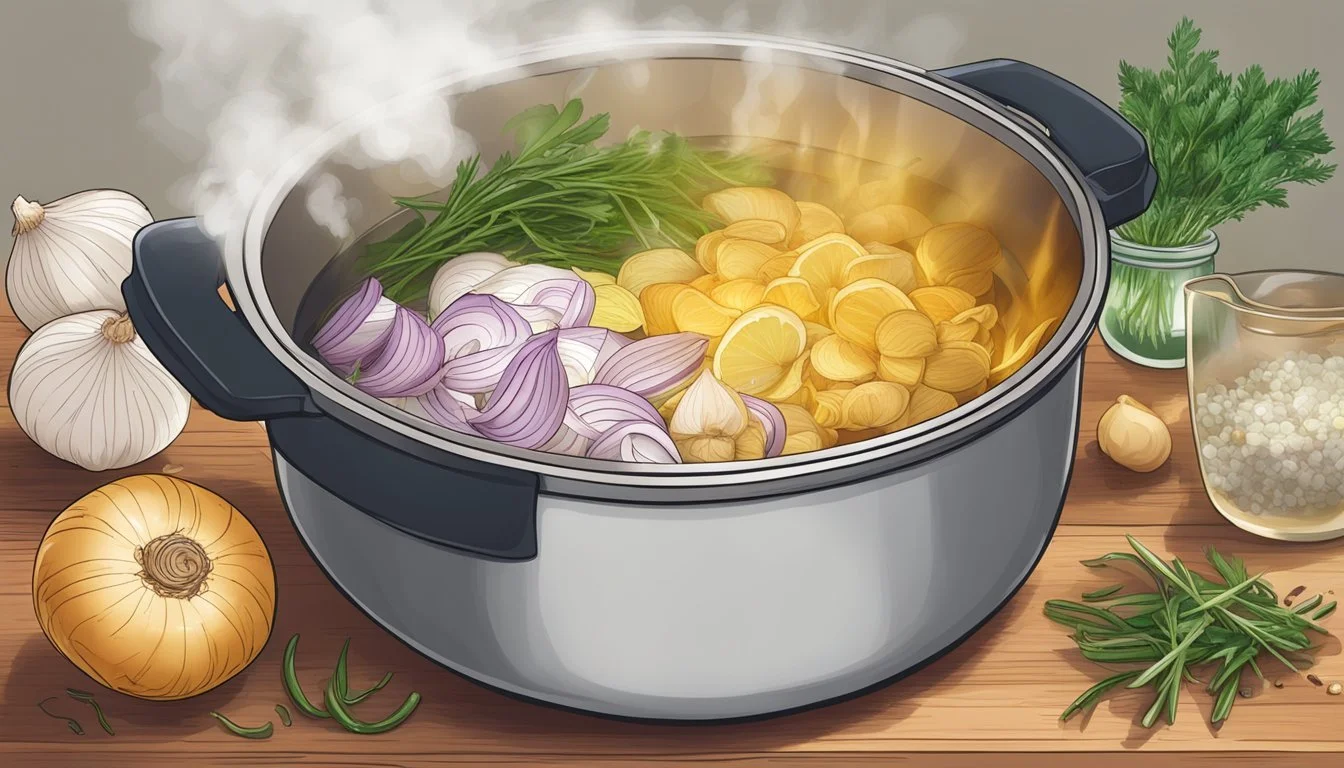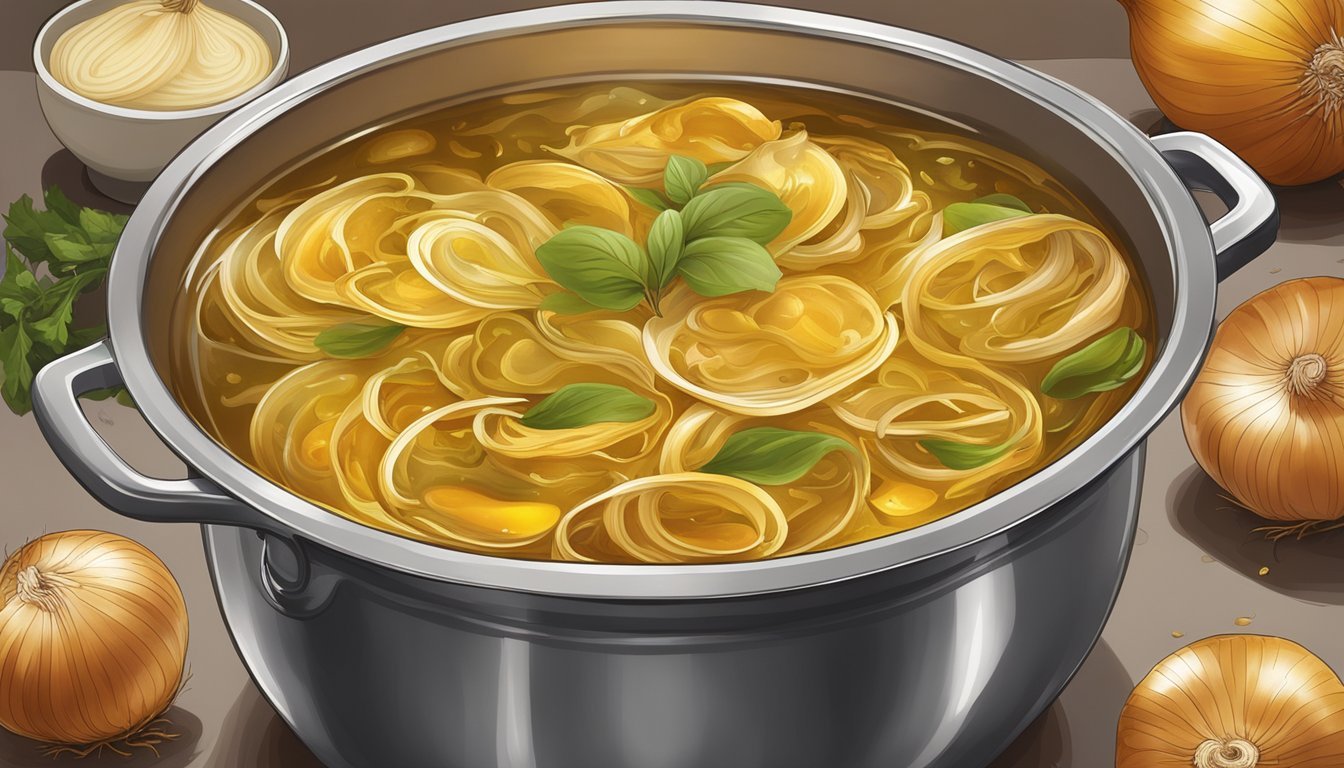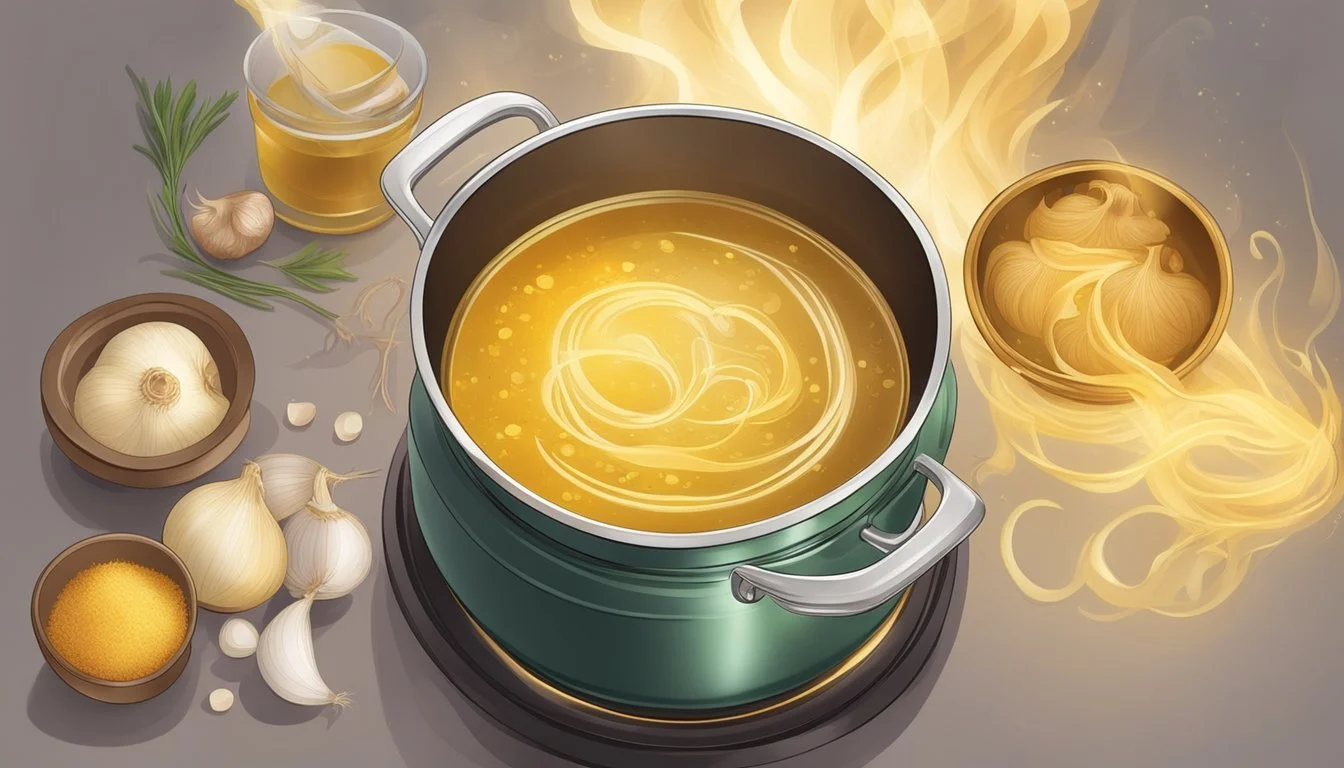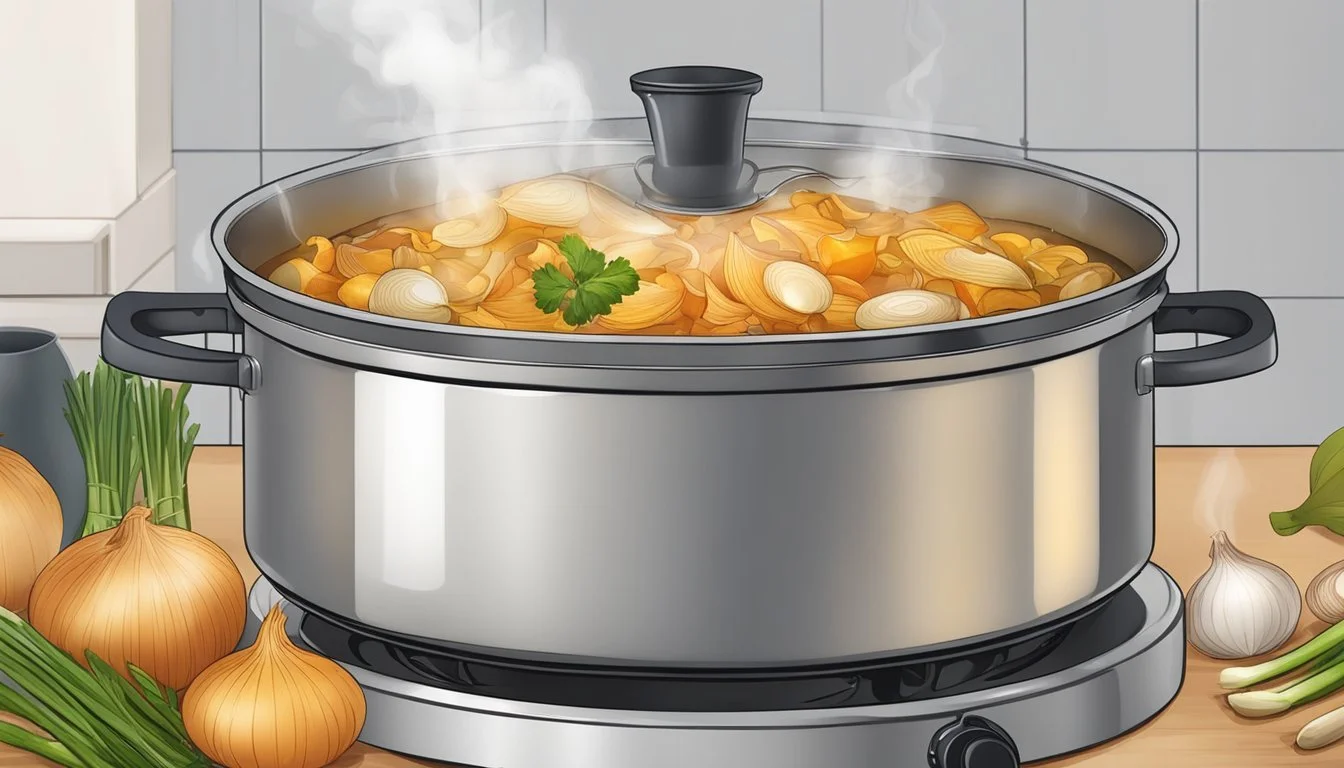Onion Skin Broth
A Culinary Secret for Richer Soups and Stews
Onion skin broth is a resourceful and sustainable way to create a flavorful base for soups and stews (What wine goes well with stews?). It harnesses the often-discarded outer layers of onions, (What wine goes well with onions?) which contain a surprising depth of flavor and color. This broth aligns with the principles of zero-waste cooking, as it encourages the use of ingredients that are typically overlooked, yet are capable of contributing rich, earthy undertones to a variety of dishes.
The process of making onion skin broth is simple and requires minimal preparation. Onion skins are collected over time and stored until enough accumulate to make a batch of broth. When simmered slowly, the onion skins impart a beautiful golden hue and a complex flavor profile to the liquid, which can serve as the cornerstone for numerous recipes ranging from classic comfort foods to innovative culinary creations.
In addition to being an economical choice, onion skin broth adds nutritional value to meals. The skins of onions are rich in antioxidants and flavonoids, which are known for their health benefits. Utilizing onion skins not only elevates the taste of dishes but also contributes to a more wholesome and satisfying culinary experience. Whether used in a hearty beef stew (What wine goes well with beef stew?) or as a simple sipper on a cold day, onion skin broth provides a depth of flavor that is unmatched by store-bought alternatives.
The Basics of Onion Skin Broth
Onion skin broth serves as a cost-effective and nutrient-dense foundation for various soups and stews. It utilizes typically discarded elements of onions to enrich dishes with deep flavors and an array of nutrients.
Defining Onion Skin Broth
Onion skin broth is a liquid made by simmering the outer layers of onions, which are often removed and discarded in the kitchen. This broth can be used as a base for soups, stews, and other dishes requiring a flavorful liquid. It harnesses the rich flavors that are abundant in the skins, infusing the broth with a savory taste characteristic of onions.
Benefits of Using Onion Skins
Using onion skins in a broth not only minimizes food waste but also provides a wealth of benefits:
Nutrition: Onion skins are high in fiber, vitamins, and minerals, including vitamin A, vitamin C, and potassium.
Flavor: They contribute a subtle depth to the broth, enhancing the overall taste of the final dish.
Color: The skins impart a rich golden to brown hue, depending on the onion variety, adding visual appeal to clear soups and stews.
Fundamental Ingredients
While the focus is on onion skins, a basic onion skin broth may include several other ingredients to complement their flavor:
Vegetables: Carrots, celery, and garlic are commonly added for complexity.
Herbs: Bay leaves, thyme, and rosemary can introduce aromatic notes.
Water: Enough to cover the ingredients, bringing out the flavors through slow simmering.
Proportions and Specifics:
Onions: The skins of 6-8 onions typically suffice.
Vegetables: 1-2 carrots, 1-2 celery stalks, 1-2 cloves of garlic.
Herbs: 1 bay leaf, a sprig of thyme, a sprig of rosemary.
Water: 12 cups, or enough to ensure all ingredients are submerged.
By integrating onion skins into the broth-making process, they add more than just flavor; they introduce essential nutrients like fiber, potassium, calcium, and other minerals that are beneficial for health.
Preparing the Ingredients
The quality of the ingredients is pivotal to the depth of flavor in onion skin broth. Careful selection and preparation set the foundation for a rich and aromatic base that elevates soups and stews.
Selecting Quality Onions
One should choose onions that are firm to the touch with dry, papery skins. These skins are crucial as they impart a rich color and flavor to the broth. Additionally, incorporating a mix of yellow, red, and white onion skins can create a more complex taste profile.
Cleaning and Prepping Vegetables
Aside from onion skins, one typically incorporates carrots, celery, and leeks into their broth. It is important to wash all vegetables thoroughly to remove any dirt, especially in the layers of the leeks. One should peel the carrots, chop them into large chunks, and cut the celery and leeks similarly.
Vegetable Prep Checklist:
Carrots: Peel and chop into chunks
Celery: Wash and cut into chunks
Leeks: Slice lengthwise, wash well, and chop into large pieces
Additional Flavor Enhancers
To further enhance the broth, various herbs and spices can be added. Garlic cloves, crushed and left to sit for 10 minutes before use, unleash their full potential in the broth. Additionally, fresh parsley, thyme, and peppercorns can be tied together in a piece of cheesecloth, creating a bouquet garni that imparts subtle flavors without leaving residue in the broth.
Herbs and Spices for Broth:
Garlic: Crush and allow to sit before adding
Parsley: Fresh, tied into a bouquet garni
Thyme: Fresh, included in the bouquet garni
Peppercorns: A few, added to the bouquet garni
Selecting high-quality vegetables and herbs, and preparing them properly, ensures a full-bodied and flavorful onion skin broth that serves as a versatile and nourishing base for many dishes.
Cooking Techniques
Creating a deeply flavorful onion skin broth requires precise cooking techniques that ensure the extraction of rich flavors from the onion skins and any accompanying ingredients. In this section, we will explore how to master the art of simmering and compare the nuances of using a slow cooker, stovetop, or Instant Pot for broth making.
The Art of Simmering
Simmering is the gentle technique of cooking ingredients just below the boiling point, where small bubbles occasionally rise to the surface. For onion skin broth, a consistent simmer allows the water to extract the flavors and nutrients from the onion skins and proteins, creating a more complex and flavorful base for soups and stews. It's important to maintain a temperature between 185°F to 205°F, preventing the broth from reaching a full boil and becoming cloudy.
Slow Cooker vs. Stovetop vs. Instant Pot
Each cooking method offers distinct advantages when preparing onion skin broth:
Slow Cooker: Ideal for long and unattended cooking, a slow cooker allows flavors to develop over time, typically 6 to 8 hours on low heat. It ensures the broth remains at a consistent simmer with minimal monitoring.
Stovetop: Offers greater control over heat levels, allowing for quicker adjustments. Cooking time generally ranges from 1 to 4 hours, depending on the desired intensity of flavor.
Instant Pot: An efficient option, the Instant Pot can significantly reduce cooking time while still providing a flavorful broth, usually completed within 1 hour using the high-pressure setting.
Comparative Table:
Method Cooking Time Temperature Control Flavor Intensity Slow Cooker 6-8 hours (Low) Consistent Well-developed Stovetop 1-4 hours Adjustable Depends on duration Instant Pot ~1 hour (High) Precise High, quickly developed
Monitoring Cooking Time
The cooking time greatly affects the richness and depth of the broth's flavor. Longer cook times allow more extraction from the onion skins and other proteins and ingredients, but careful monitoring is essential to prevent overcooking. For a more robust flavor, extending the simmering time on the stovetop can be beneficial, while a slow cooker might require less frequent checks. In contrast, an Instant Pot's pre-programmed settings can simplify the process and ensure a consistent result without overcooking.
Enhancing the Broth
A well-crafted broth serves as the cornerstone for soups and stews, and careful selection of meats, herbs, and seasoning is essential. This deliberate process enriches the broth and provides a robust flavor foundation.
Incorporating Meats and Protein
For a richer onion skin broth, chefs often recommend a mix of meats. Chicken is especially favored for its ability to impart a mild but savory taste. Adding various cuts, such as bone-in pieces, enhances the complexity due to the marrow and collagen that seeps into the broth, intensifying both flavor and texture.
Chicken: Add bone-in pieces for depth.
Lean and Fatty Cuts: A combination adds complexity.
Utilizing Fresh vs. Dried Herbs
Herbs play a pivotal role in broth-making. Fresh herbs, such as parsley, thyme, and rosemary, offer bright and vibrant flavors, while dried herbs, like bay leaves, have a more concentrated taste that infuses the broth over time. The choice between fresh and dried herbs depends on the desired intensity and flavor profile.
Fresh Herbs: Add at the end for bright flavors.
Dried Herbs: Use at the start for a deeper essence.
Adjusting for Salt and Seasoning
Salt is crucial in broth-making, acting not only as a seasoning but also enhancing the natural flavors of other ingredients. Begin with a modest amount and adjust gradually. Black pepper adds a warm, piquant note, while a splash of vinegar can brighten the overall profile without overwhelming the inherent flavors of the onion skin broth.
Salt: Start with less, adjust as needed.
Pepper: A hint for warmth.
Vinegar: Just a splash for brightness.
Storage and Preservation
When dealing with homemade onion skin broth, proper storage is crucial for maintaining its rich flavor and nutritional value. Two prime methods are refrigerating for immediate use and freezing for extending its shelf life.
Cooling and Storing in the Refrigerator
Once the onion skin broth has been prepared, it should be allowed to cool to room temperature. Prompt cooling minimizes the growth of bacteria. It should then be transferred to mason jars or other airtight containers, ensuring that any fat has been skimmed off to preserve freshness. In the refrigerator, the broth can be stored and used as a nutritious base for soups and stews for up to 4-5 days.
Freezing for Long-Term Use
For longer storage, freezing is an effective method to retain the broth's tastes and health benefits. Portion the cooled broth into suitable containers, leaving an inch of headspace to allow for expansion. Secure lids tightly and label each container with the date. Frozen onion skin broth can last in the freezer for several months, making it a convenient ingredient for future culinary use. To thaw, one should transfer the needed amount into the refrigerator a day before use or defrost gently in a microwave or a pot over low heat.
Keeping Nutrient-Rich Quality
To ensure the onion skin broth retains its nutrient-rich quality during storage, use only fresh ingredients during preparation and avoid prolonged exposure to heat after cooking. The respiratory enzymes in onions become inactive once frozen, safeguarding the broth’s vitamins and minerals. Storing the broth properly, whether in the refrigerator for short-term use or in the freezer for long-term storage, will help maintain its healthful properties.
Usage in Recipes
Onion skin broth serves as a rich canvas for culinary creativity, infusing dishes with a complex depth of flavor. This nutrient-rich liquid made from onion peels is low in carbohydrates and sugars, yet high in savory undertones, making it an excellent base for an array of recipes.
Creating Soups and Stews
Onion skin broth is an ideal starting point for creating hearty soups and stews. It adds a robust flavor without overpowering the other ingredients. For example, in a classic chicken noodle soup, onion skin broth can provide a flavorful base that complements the chicken and vegetables, while contributing minimal carbohydrates and sugars. An example recipe would be:
Chicken Noodle Soup:
2 quarts onion skin broth
1 cup diced carrots
1 cup diced celery
2 cups shredded chicken
6 ounces uncooked noodles
Salt and pepper to taste
Prepare the broth using onion skins, simmer with carrots and celery until tender, then add the chicken and noodles, cooking until the noodles are al dente.
Beyond Soups: Sauces and More
Besides its traditional role in soups and stews, onion skin broth can also be the base for a variety of sauces, enhancing their flavor profile. When creating a gravy or a reduction, the broth imparts a savory quality that complements ingredients like herbs, spices, and the main protein. The broth's versatility shines in both vegetarian and meat-based sauces.
Innovative Ideas
Chefs and home cooks are constantly seeking innovative ways to incorporate healthy, flavorful ingredients into their recipes. Onion skin broth can be used in less conventional ways such as in braising liquids, as a deglazing agent for sautéed vegetables, or even as a warm beverage, seasoned with herbs. It's a versatile tool that delivers a savory taste and a boost of iron without unnecessary sugars or carbohydrates, meeting the needs of those who are health-conscious or seeking to infuse their meals with greater nutritional value.
Nutritional Considerations
Onion skin broth is not only a culinary treasure but also a powerhouse of nutrients that contribute to a balanced diet. This section explores its nutritional value, including health benefits, macro and micronutrient content, and its place in vegetarian and vegan diets.
Health Benefits of Onion Skin Broth
Onion skins are known to be rich in antioxidants, which can help protect the body against free radicals. Flavonoids, particularly quercetin, are abundant in onion skins and contribute to the broth's health-promoting properties. These antioxidants are associated with reducing inflammation, lowering the risk of heart disease, and supporting immune function.
Macro and Micronutrient Content
Onion skin broth is low in calories, making it an excellent choice for those monitoring their caloric intake. The broth contains a modest amount of fiber, which can aid in digestion and promote satiety. While onion skin broth is typically not a significant source of collagen, it does contain various micronutrients such as vitamins and minerals essential for maintaining good health.
Dietary Inclusions: Vegetarian and Vegan
As a plant-based ingredient, onion skin broth is inherently suitable for vegetarian and vegan diets. It offers a nutrient-rich alternative to traditional broths that often rely on animal products. For vegans in particular, this broth can be an excellent base to ensure that they are incorporating various nutrients into their diet without the use of meat or animal byproducts.
Comparison to Alternatives
Selecting the right type of broth can greatly impact the quality and flavor of soups and stews. Onion skin broth, known for its richness, competes with various alternatives, each with pros and cons in terms of flavor, cost, and convenience.
Homemade vs. Store-Bought Broth
Homemade Broth: A homemade onion skin broth is typically more flavorful than store-bought alternatives due to the fresh ingredients and the ability to adjust the cooking time and seasoning to taste. One can control the quality of ingredients, which often translates to a healthier and more flavorful broth.
Store-Bought Broth: In contrast, store-bought broths, while convenient, often contain preservatives and high sodium levels. However, they save significant preparation time and are consistently available, which makes them a suitable choice for quick meal preparations.
Vegetable Broth as an Alternative
Vegetable Broth: It is a viable alternative for vegetarians and those looking to avoid animal products. While vegetable broth, including those made without onion and garlic, offers versatility, it can lack the depth of flavor that bone-based broths, like onion skin broth, typically have.
Bone Broth: Bone broth, such as chicken stock or beef broth, usually offers a richer taste and texture due to the gelatin released from bones during long simmering periods. Onion skin broth, being a part of the bone broth family, shares this characteristic of having a deeper flavor profile compared to vegetable broth.
Economic Considerations
Expense: Homemade onion skin broth can be economical as it allows the use of kitchen scraps that might otherwise go unused, such as onion peels. Store-bought broth can be more expensive, especially if one opts for organic or specially-branded versions.
Yield: Homemade broth typically yields a large quantity, which can be frozen for future use, providing both a cost-effective and time-saving solution over multiple cooking sessions. Store-bought broths are fixed in volume, and frequent purchases are necessary for regular use, which can increase the overall expense.
Enhancing Your Kitchen Practices
Maximizing the value of kitchen scraps and perfecting broth-making techniques are quintessential for creating a flavorful onion skin broth. Implementing efficient straining methods and repurposing leftovers further elevates a chef's culinary acuity.
Utilizing Kitchen Scraps
Chefs can transform vegetable scraps, such as onion skins, carrot peels, parsnip ends, and shallot skins, into a rich broth base. They should collect these scraps in a container stored in the refrigerator or freezer until there is a sufficient amount to make a broth, ensuring no waste of flavorful materials.
Strategies for Skimming and Straining
A key step in broth-making is skimming off impurities to achieve clarity and purity of flavor. Chefs typically use a fine-mesh skimmer during the initial stages of simmering to remove foam and fat from the surface. For straining, a fine-mesh sieve lined with cheesecloth ensures that the broth is free of solids for a smooth texture.
Creative Leftover Ideas
Even after straining, components like softened vegetables and softened parsnips possess flavor that can be repurposed. Chefs may blend these leftovers to make a thickening agent for soups or stews, or they can incorporate them into dishes like fritters or croquettes, adding nutritional value and reducing food waste.

